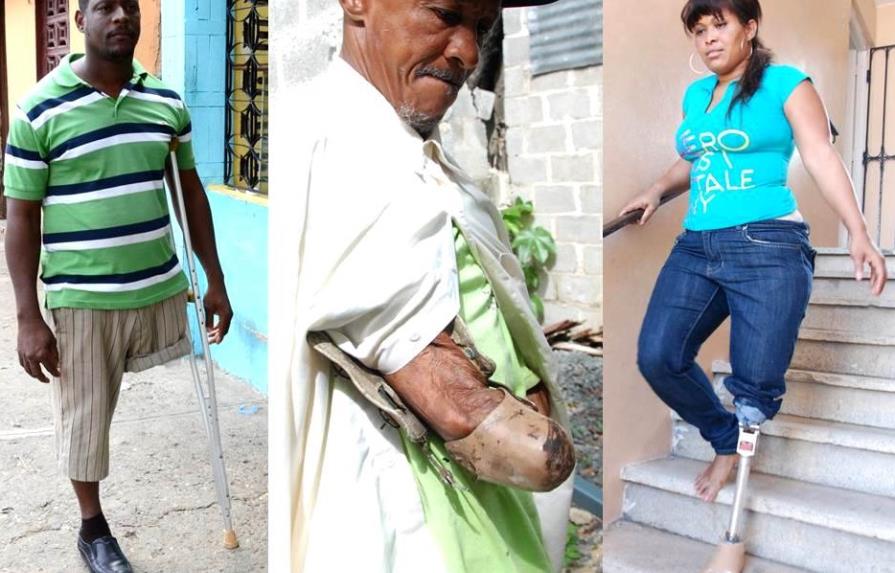When the body needs a prosthetic device

SANTO DOMINGO. Julio Candelario keeps an old copy of the defunct magazine "Sucesos". The addition is from 23 June 1997. He appears on the cover sitting in a bed, with his body full of sores, bandaged from the neck to the hip and without his forearms. The publication talks about his suffering after being electrocuted by a high tension cable.
At 51, he lives in Los Alcarrizos, next to a creek, in a half-built house, with a dirt and cement floor. After failing at the family level and with a small business of selling lubricants, he receives a limited assistance from the state. The old prosthesis which he managed to obtain with the help of the Presidential Social Plan, at a cost of RD$65,000, is no longer any good. He uses the two fragments of arms which he has to carry out domestic and physical functions and even to write.
In another sector, in Capotillo, Daniel Heredia, 36, remembers that he went with the Civil Defense to Haiti to assist those affected by the earthquake in January 2010. The father of seven children, he felt pleased with his humanitarian efforts. Two months later, walking at night through the barrio, several delinquents shot him in his left leg. Today he walks with a crutch and takes advantage of the economic assistance from a pension as a policeman and from a brother.
On the outskirts of the capital, in Boca Chica, there is a victim of the earthquake in which Heredia gave assistance. A Haitian immigrant, 22, told Diario Libre that she was trapped for 13 days in the rubble of the school where she studied. She was rescued and given medical assistance. When she woke up she realized that she did not have all of her legs. She was more than depressed because her mother also was killed.
An NGO donated a set of prosthetic devices. With the help of her sister, she obtained RD$13,000 to cross the frontier illegally. Today she lives with a friend in a small room, surrounded by Dominican neighbors. She walks with difficulty, supported on her prosthetic legs, now old and much repaired.
The three amputees say that with good prosthetic devices they could work, an idea that coincides with many people with some type of impediment that seek opportunities in a closed market. They hope that this will come true by being on a list of beneficiaries of the Dominican Technical Orthopedic and Rehabilitation Foundation (Fundotecyr), headed by Felipe Felix, a 46-year-old Dominican, who after 11 years working at the Dominican Rehabilitation Association, emigrated to the United States and makes prosthetic devices for donation.
The inventory that he is currently working on adds up to 42 - 8 for upper members and 34 for lower members - with an estimated value of US$150,000. He programmed their delivery at the end of the month but because of the lack of resources to complete the materials, the date is now indefinite. He covers some costs, such as labor, or obtains donations from the company where he works. This is what he did for another 10 apparatus which he delivered in August 2014 which cost US$42,000.
"We were with President Danilo Medina in November (2014), in his office, and he promised us that he was going to collaborate with these cases, but we have not received any answer yet," he complained.
Between costs and necessity
In the most recent population census of 2010, there were 15,468 persons in the country without one or both legs and 10,674 without one or both arms. They represent 0.3% of the population.
The prosthesis most required by those who have access are the trans-femoral devices, followed by the trans - tibia devices and in last place devices for the upper extremities, explains Dr. Juan Guillot Caba, the president of the Orthopedic Society.
Alan Mendez, which is in charge of the orthopedic laboratory of the Dominican Rehabilitation Association, indicates that a prosthesis can have a useful life of up to five years. If it is treated well, they could last longer. Depending on the level of the amputation and the quality of the materials, costs can go from RD$10,000 and up to more than RD$500,000.
Those patients with scarce economic resources who are not affiliated with Social Security are removed from the productive life because they can't afford these items. Others seek help in non-profit organizations and government institutions.
The Social Plan of the Presidency as a formal program for assistance of this type, which among other requisites requires that the applicant present a letter of evaluation by a doctor and a quotation. Through its Department of Assistance for Disability, between 2009 and 2015 they have benefited 18 persons spending RD$1,017,558. The most expensive prosthetic device during this period was for a woman, who lost both lower extremities, and cost RD$107,791.
For the affiliates of the subsidized regime, the law requires that the coverage will be 100%, no matter what the cause. In the payroll deduction regime, if the amputation is because of traumas, it will cover up to RD$1 million; for a work related injury 100%; for an event which is included in the National Fund of Medical Attention to Traffic Accidents (Fonamat), up to 40 minimum wages; and based on the catalog of services of the Health Service Plan (PDSS) the patient will pay 20%.
Between 2012 and 2014, the Administrator of Labor Risks Health Insurance (ARLSS) paid RD$12.3 million for 246 services of prosthetics.
Nevertheless, the Directorate of Information and Defense of the Affiliates (DIDA) receives complaints from patients, whose insurers do not approve the coverage. In addition, not all of the Health Risk Administrators (ARS) have agreements with the laboratories which manufacture them. In the case of the Dominican Rehabilitation Association, the pioneer in the country of the manufacture of prosthesis, only 12 of 24 ARS cover those apparatus which they make in their orthopedic workshop.
Fribio Castellanos, the internal medical advisor of the DIDA, feels that there is a need to revise the catalog of health services in order to establish more adequate coverage. "If we are in a coverage of 80(%), one would hope that it would be 100%," he says as a member of the commission that studies the expansion and updating of the PDSS catalog of the Contributive Regime (payroll deduction), he points out that the moment has arrived to revise the chapter on prosthetic devices, which should be studied with special attention.
"There should be a program or a rehabilitation committee that handles a fund for persons of little or no economic resources - says Doctor Guillot - which provides a follow-up of these resources for those persons, and gives incentives to both the government as well is the citizens to give the persons with disabilities a new opportunity within society."
Why should it improve?
The Dominican Republic is one of the principal countries with the most cases of traffic accidents. In those events, the victims can lose an extremity which limits their quality of life. During 12 years of the registers of the Dominican Rehabilitation Association, 31% of the amputees attended had their origin in one of these events.
Among these victims is Paula Guzman, a 33 year old mother and nursing student. Having a prosthesis donated by the Fundotecyr keeps her active; she even plays basketball and participates in marathons.
At 10 o'clock at night on Holy Friday, in 1995, she was struck by a car when she was crossing 27 February Ave. Her left leg was destroyed and it was amputated. "God gave me a lot of strength and I held on to Him," she says in a choked voice.
Without the leg, she used to fall from her bed, and suffered moments of depression. She walked with crutches for a time. Not having any medical insurance, her family helped paid for a prosthesis valued at RD$70,000. When it began to wear out, she made adaptations and fixed it up, until it could not be fixed anymore, and she returned to the crutches. In August 2014 she received a new prosthesis. "I consider myself a normal person, but through the few probabilities that there are for work for us, then I can say that they are not going to give me a job, not because I don't try to get one, but because I know the area of people with disabilities, and at times I become depressed when I see my companions that have need of a job and it is not facilitated," Paula concludes.
Dominican innovation in prosthesis
The laboratories in the country which fabricate prosthetic devices are not all formally recognized. Within those that are, there is Orthopedic Innovation. The work by their personnel with patients has permitted them to develop a system which was selected for presentation in June at a world Congress on prosthesis and braces in France.
Carlos Gutierrez, an orthopedic technologist at the center, explains that the achievement consists in the possibility of transferring the adjustments of a dynamic alignment of a temporary prosthesis to the permanent prosthesis so that when the patient uses it he can do it with a greater similarity to his natural member. "All those biomechanical achievements that one achieves, of movement, rotation, inclination, height and axis, have to be duplicated in the definitive prosthetic device," he explains.
This system is supported on a small plaster bar with levels, placed at a specific point, which conserves the information of the test prosthesis.
At 51, he lives in Los Alcarrizos, next to a creek, in a half-built house, with a dirt and cement floor. After failing at the family level and with a small business of selling lubricants, he receives a limited assistance from the state. The old prosthesis which he managed to obtain with the help of the Presidential Social Plan, at a cost of RD$65,000, is no longer any good. He uses the two fragments of arms which he has to carry out domestic and physical functions and even to write.
In another sector, in Capotillo, Daniel Heredia, 36, remembers that he went with the Civil Defense to Haiti to assist those affected by the earthquake in January 2010. The father of seven children, he felt pleased with his humanitarian efforts. Two months later, walking at night through the barrio, several delinquents shot him in his left leg. Today he walks with a crutch and takes advantage of the economic assistance from a pension as a policeman and from a brother.
On the outskirts of the capital, in Boca Chica, there is a victim of the earthquake in which Heredia gave assistance. A Haitian immigrant, 22, told Diario Libre that she was trapped for 13 days in the rubble of the school where she studied. She was rescued and given medical assistance. When she woke up she realized that she did not have all of her legs. She was more than depressed because her mother also was killed.
An NGO donated a set of prosthetic devices. With the help of her sister, she obtained RD$13,000 to cross the frontier illegally. Today she lives with a friend in a small room, surrounded by Dominican neighbors. She walks with difficulty, supported on her prosthetic legs, now old and much repaired.
The three amputees say that with good prosthetic devices they could work, an idea that coincides with many people with some type of impediment that seek opportunities in a closed market. They hope that this will come true by being on a list of beneficiaries of the Dominican Technical Orthopedic and Rehabilitation Foundation (Fundotecyr), headed by Felipe Felix, a 46-year-old Dominican, who after 11 years working at the Dominican Rehabilitation Association, emigrated to the United States and makes prosthetic devices for donation.
The inventory that he is currently working on adds up to 42 - 8 for upper members and 34 for lower members - with an estimated value of US$150,000. He programmed their delivery at the end of the month but because of the lack of resources to complete the materials, the date is now indefinite. He covers some costs, such as labor, or obtains donations from the company where he works. This is what he did for another 10 apparatus which he delivered in August 2014 which cost US$42,000.
"We were with President Danilo Medina in November (2014), in his office, and he promised us that he was going to collaborate with these cases, but we have not received any answer yet," he complained.
Between costs and necessity
In the most recent population census of 2010, there were 15,468 persons in the country without one or both legs and 10,674 without one or both arms. They represent 0.3% of the population.
The prosthesis most required by those who have access are the trans-femoral devices, followed by the trans - tibia devices and in last place devices for the upper extremities, explains Dr. Juan Guillot Caba, the president of the Orthopedic Society.
Alan Mendez, which is in charge of the orthopedic laboratory of the Dominican Rehabilitation Association, indicates that a prosthesis can have a useful life of up to five years. If it is treated well, they could last longer. Depending on the level of the amputation and the quality of the materials, costs can go from RD$10,000 and up to more than RD$500,000.
Those patients with scarce economic resources who are not affiliated with Social Security are removed from the productive life because they can't afford these items. Others seek help in non-profit organizations and government institutions.
The Social Plan of the Presidency as a formal program for assistance of this type, which among other requisites requires that the applicant present a letter of evaluation by a doctor and a quotation. Through its Department of Assistance for Disability, between 2009 and 2015 they have benefited 18 persons spending RD$1,017,558. The most expensive prosthetic device during this period was for a woman, who lost both lower extremities, and cost RD$107,791.
For the affiliates of the subsidized regime, the law requires that the coverage will be 100%, no matter what the cause. In the payroll deduction regime, if the amputation is because of traumas, it will cover up to RD$1 million; for a work related injury 100%; for an event which is included in the National Fund of Medical Attention to Traffic Accidents (Fonamat), up to 40 minimum wages; and based on the catalog of services of the Health Service Plan (PDSS) the patient will pay 20%.
Between 2012 and 2014, the Administrator of Labor Risks Health Insurance (ARLSS) paid RD$12.3 million for 246 services of prosthetics.
Nevertheless, the Directorate of Information and Defense of the Affiliates (DIDA) receives complaints from patients, whose insurers do not approve the coverage. In addition, not all of the Health Risk Administrators (ARS) have agreements with the laboratories which manufacture them. In the case of the Dominican Rehabilitation Association, the pioneer in the country of the manufacture of prosthesis, only 12 of 24 ARS cover those apparatus which they make in their orthopedic workshop.
Fribio Castellanos, the internal medical advisor of the DIDA, feels that there is a need to revise the catalog of health services in order to establish more adequate coverage. "If we are in a coverage of 80(%), one would hope that it would be 100%," he says as a member of the commission that studies the expansion and updating of the PDSS catalog of the Contributive Regime (payroll deduction), he points out that the moment has arrived to revise the chapter on prosthetic devices, which should be studied with special attention.
"There should be a program or a rehabilitation committee that handles a fund for persons of little or no economic resources - says Doctor Guillot - which provides a follow-up of these resources for those persons, and gives incentives to both the government as well is the citizens to give the persons with disabilities a new opportunity within society."
Why should it improve?
The Dominican Republic is one of the principal countries with the most cases of traffic accidents. In those events, the victims can lose an extremity which limits their quality of life. During 12 years of the registers of the Dominican Rehabilitation Association, 31% of the amputees attended had their origin in one of these events.
Among these victims is Paula Guzman, a 33 year old mother and nursing student. Having a prosthesis donated by the Fundotecyr keeps her active; she even plays basketball and participates in marathons.
At 10 o'clock at night on Holy Friday, in 1995, she was struck by a car when she was crossing 27 February Ave. Her left leg was destroyed and it was amputated. "God gave me a lot of strength and I held on to Him," she says in a choked voice.
Without the leg, she used to fall from her bed, and suffered moments of depression. She walked with crutches for a time. Not having any medical insurance, her family helped paid for a prosthesis valued at RD$70,000. When it began to wear out, she made adaptations and fixed it up, until it could not be fixed anymore, and she returned to the crutches. In August 2014 she received a new prosthesis. "I consider myself a normal person, but through the few probabilities that there are for work for us, then I can say that they are not going to give me a job, not because I don't try to get one, but because I know the area of people with disabilities, and at times I become depressed when I see my companions that have need of a job and it is not facilitated," Paula concludes.
Dominican innovation in prosthesis
The laboratories in the country which fabricate prosthetic devices are not all formally recognized. Within those that are, there is Orthopedic Innovation. The work by their personnel with patients has permitted them to develop a system which was selected for presentation in June at a world Congress on prosthesis and braces in France.
Carlos Gutierrez, an orthopedic technologist at the center, explains that the achievement consists in the possibility of transferring the adjustments of a dynamic alignment of a temporary prosthesis to the permanent prosthesis so that when the patient uses it he can do it with a greater similarity to his natural member. "All those biomechanical achievements that one achieves, of movement, rotation, inclination, height and axis, have to be duplicated in the definitive prosthetic device," he explains.
This system is supported on a small plaster bar with levels, placed at a specific point, which conserves the information of the test prosthesis.


 Mariela Mejía
Mariela Mejía
 Mariela Mejía
Mariela Mejía